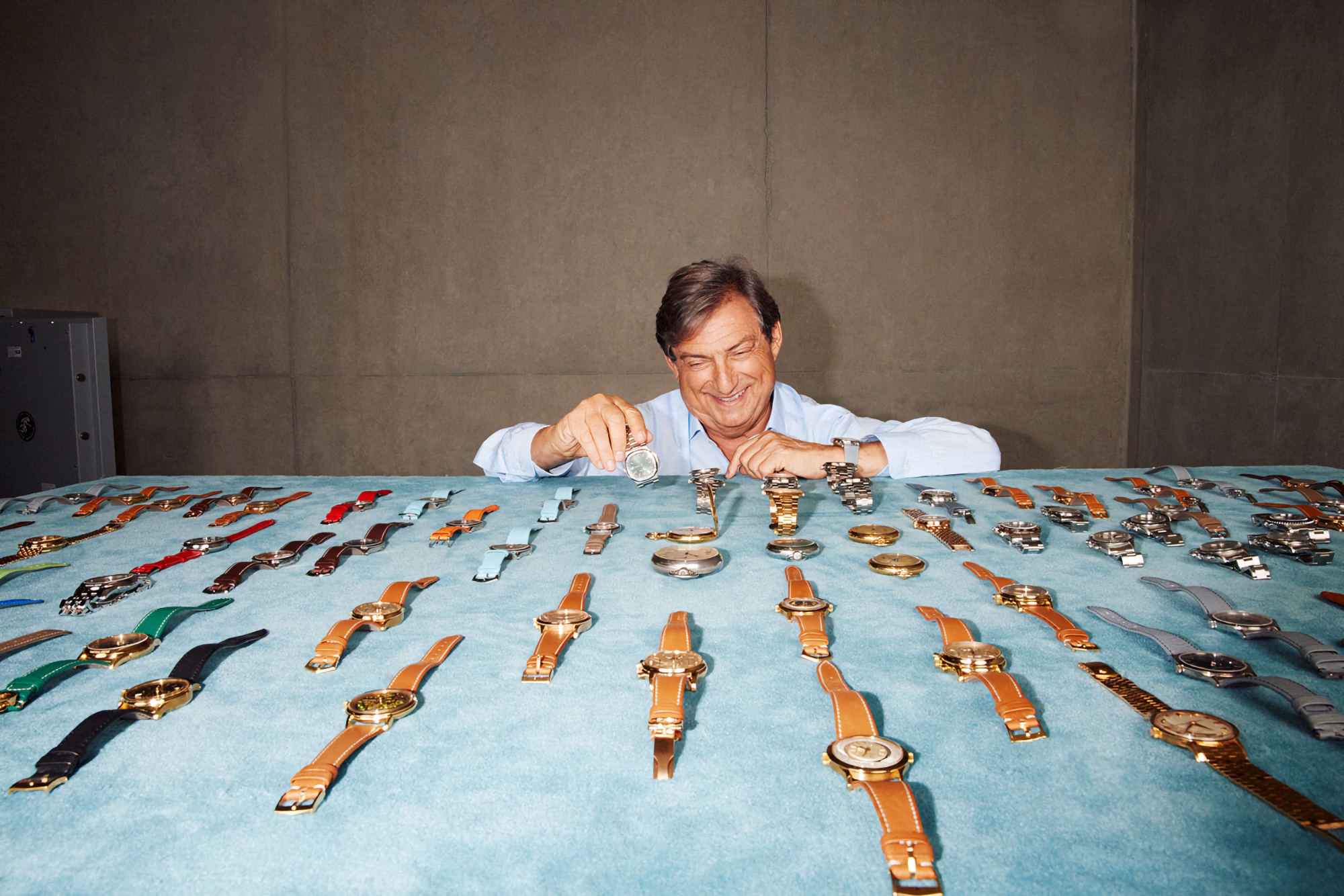At the age of 12, when most boys are peering into the windows of candy shops, Patrick Getreide was pressing his nose against the glass of watch boutiques. Such is the danger of attending boarding school in a city like Geneva. Getreide passed by a particular store every day on his way to school and began to covet one of the watches, an Omega. “I looked in the window 50 times, and on the 51st time, I went in and announced that I wanted to buy the watch,” says Getreide. “Of course, I didn’t have the money. I had five francs per week for pocket money. But the guy liked me — he was impressed that a 12-year-old kid wanted to buy a watch — and he said, “It’s fine.” So, I was giving him five francs every week. It went on for weeks, and one day I called my father and I said, If I pay by five francs a week, it’s two years or more before I can own it, so my father paid out.”

Monsieur Getreide
Over the next four decades, Getreide went deep down the watch collector rabbit hole, and today, his 600-piece collection is one of the most valuable and historically important in the world. It is now on display at the British Design Museum, the first stop on a world tour that will include New York City. It is the first private watch collection to exhibit in either a gallery or museum. With the help of his advisors, Getreide narrowed his treasures down to 168 representative samples in 11 categories, which collectively represent some of watchmaking’s most important milestones over the past 100 years.

The opening reception for the OAK Collection, at the British Design Museum.
To open the show, Getreide threw a party for 700 industry insiders, collectors, and press, who, between sips of Ruinart, made the three-flight journey up the steps of the museum’s vast atrium to visit the far corner rooms housing the collection. Even the most seasoned among us had never seen anything quite as thrilling as the OAK collection. There are plenty of grail watches to be seen at auction previews, but an auction is something different — it’s a mishmash of different tastes, qualities, and levels of rarity. The OAK collection is a carefully curated, coherent group of timepieces chosen by a man whose standards, like his passion for collecting, have never wavered. He had three criteria: The watches had to be one-of-a-kind or from a small series; they had to be in perfect condition, preferably new old stock (“It must be like new, even if it’s 70-years-old”); and they had to be aesthetically beautiful, a subjective criterion that, in this case, reveals Getreide’s preference for design purity if not outright minimalism. Even the sports watches in the collection, most of which are vintage and therefore sized a bit smaller, remain elegant and wearable. There are no chunky aviator watches in the mix (not even a Patek Philippe Calatrava Travel Time), no hulking divers made of brightly colored space-age materials. And no bling, with the exception of two pieces whose bezels are discreetly set with diamonds. Getreide paid a world record price 25 times to acquire pieces in the collection, which is valued unofficially at between $300 million and $400 million.
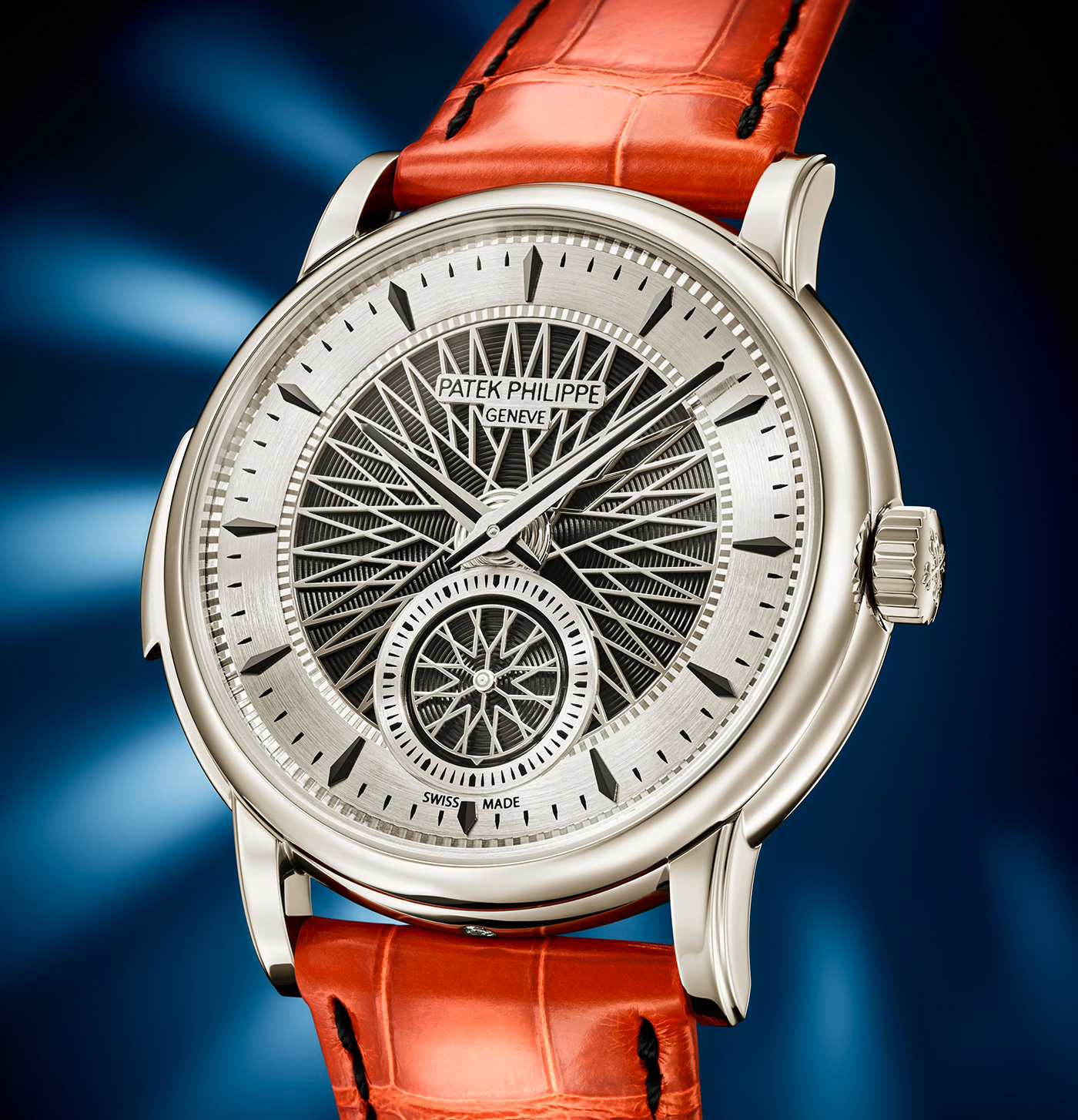
Patek Philippe Ref. 5750 Advanced Research Minute Repeater in platinum, one of 15 pieces.
The OAK collection is still growing. When I met with Getreide the day before the exhibit opened, the first thing he showed me was a Patek Philippe Ref. 5750 Advanced Research Minute Repeater, one of 15 pieces introduced only last December. He had just taken delivery. When I asked what constituted his grail piece, he mentioned two. The first is a Patek Philippe Ref. 1518 perpetual calendar chronograph in steel, probably the single-most collectible model in the entire Patek oeuvre. Only four models exist, and he knows where they are; he estimates he would have to pay upwards of $20 million to get one. His second grail is a piece that once got away. A few years ago, he nearly bought the “Churchill Victory Watch,” when it came up for sale at Sotheby’s. The yellow-gold pocket watch was commissioned by a group of Swiss citizens in 1945 to commemorate the Allied victory after WWII. It was one of four created for the Allied leaders — the others were given to Charles de Gaulle, Joseph Stalin, and Henry Truman. It has a V for Victory proudly engraved on the caseback to celebrate Churchill’s wartime leadership. On the dial of the pocket watch, a cloisonné enamel painting of St. George, England’s patron saint, is depicted with a trident in his hand slaying the dragon. It was made by Agassiz and Co. and watchmaker Louis Cottier, who specialized in world timers, many of which he made for Patek Philippe. “At the time, I felt the watch didn’t obey my rules,” says Getreide. “It was not in good condition. It was all smashed up. I think he played football with it. Today, I regret it a little bit, because Winston Churchill is my hero. Now, I’m a little older, I would maybe buy it.”
Here is a glimpse of some of the pieces in the OAK Collection, organized into 11 categories:
Patek Philippe Perpetual Calendar Chronographs

Patek Philippe Ref. 1518 known as the “pink on pink.” One of a kind.
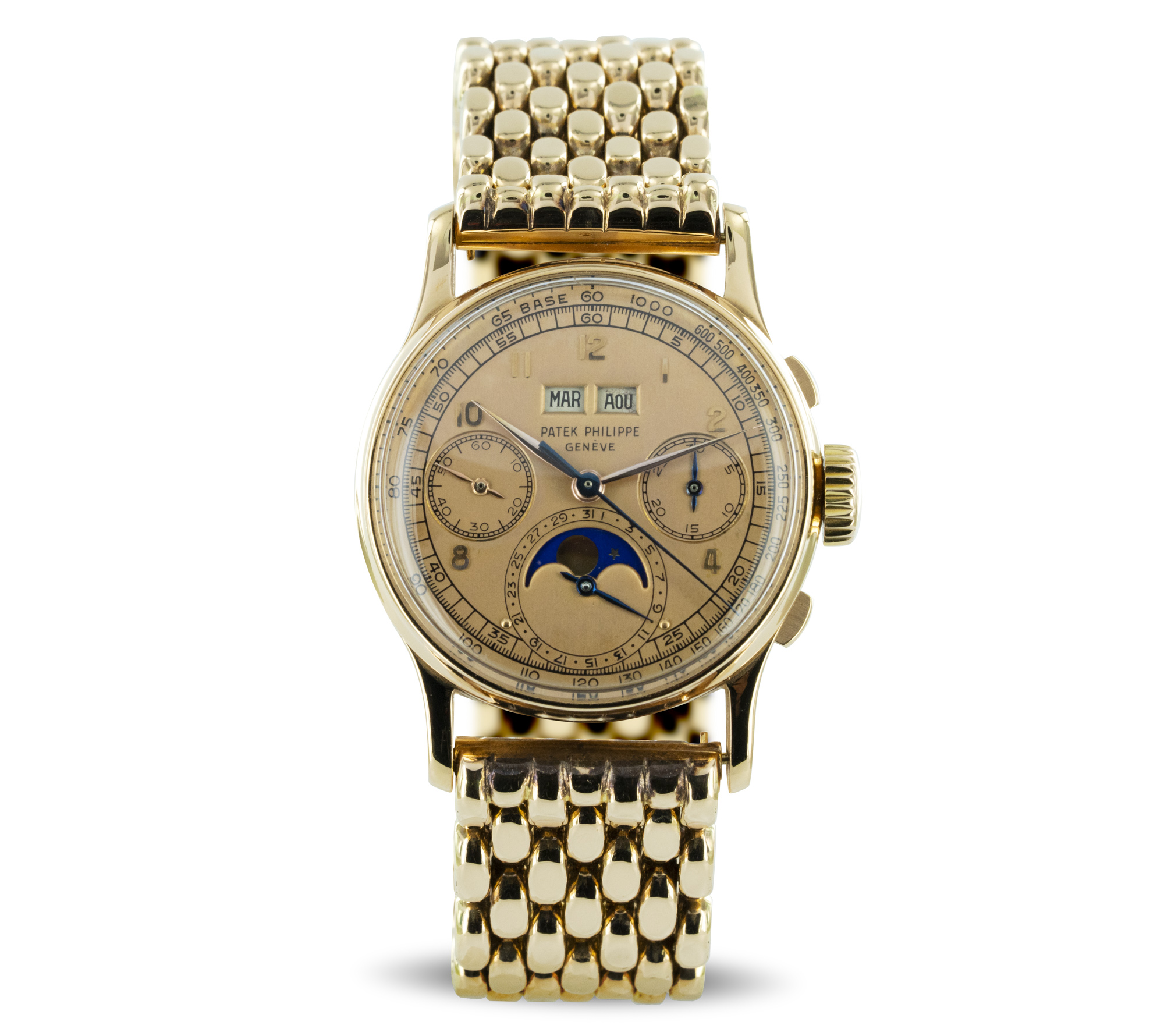
Patek Philippe Ref. 1518 known as the “pink on pink.” One of a kind.
The star of this category — in fact, of the entire exhibition — is the Patek Philippe Ref. 1518 known as the “pink on pink.” The 1518 was the original version of Patek’s first series-produced perpetual calendar chronograph, which became its signature complication. It was also a world first. Patek made 281 examples of the 1518 from 1941 to 1954. About 55 were made in pink gold, but the “pink on pink” is one-of-a-kind, with a pink dial to match the pink gold case and the original pink-gold bracelet made by Gay Frères. The design, with its two chronograph registers at 3 and 9, day and month openings, circular date display, and moonphase at 6 o’clock, established the design architecture for Patek’s subsequent perpetual calendar chronographs, the 1518’s successors: references 2499 (made from 1951 to 1985 with a total production of only 349 pieces), the 3970 (made from 1986 to 2003), the 5970 (made from 2004 to 2010) and today’s 5270.
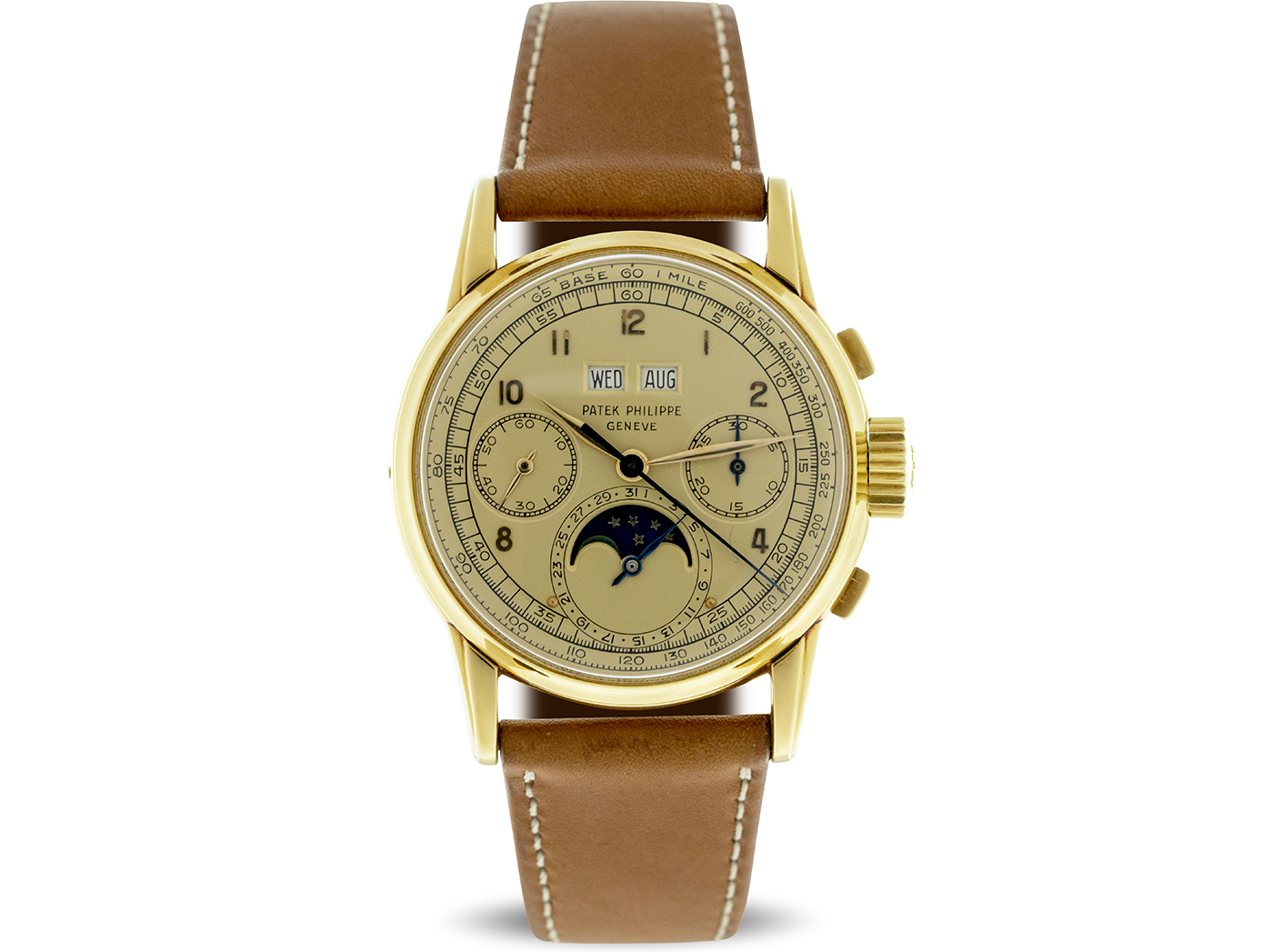
The Patek Philippe Ref. 2499 J, a second-series yellow gold in new-old-stock condition. It is one of the best such known examples.
Just as prized as the 1518 is its successor, the rare 2499. Fewer than 400 pieces were produced altogether, and Getreide’s collection includes one from each of the four series made between 1951 and 1985. The Ref. 2499 J pictured above, made circa 1960, is a second-series piece in yellow gold in new-old-stock condition. It is one of the best such known examples and was made to Geneva Seal standards. The ref. ref. 3970, introduced in 1986, was the successor to the 2499 (below).
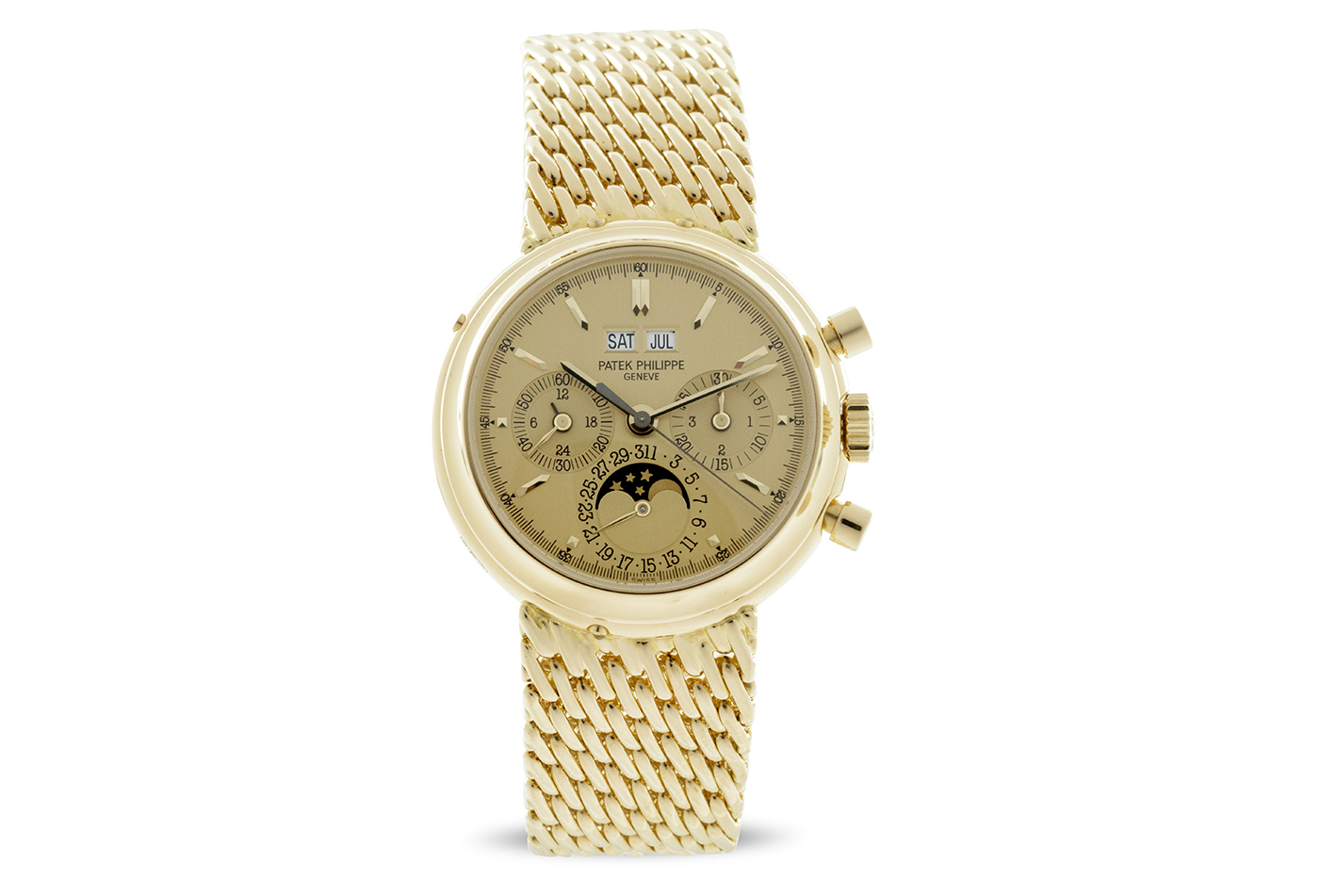
Patek Philippe Ref. 3970/2J in yellow gold with a gold bracelet.
Two outstanding one-of-a-kind 3970s in the collection were commissioned by collectors. They include the outstanding 3970/2J in yellow gold with a gold bracelet (above); and the 3970R a special order made in 1993 in pink gold with diamond indexes. Both contain the manual wound caliber CH 27-70 Q.
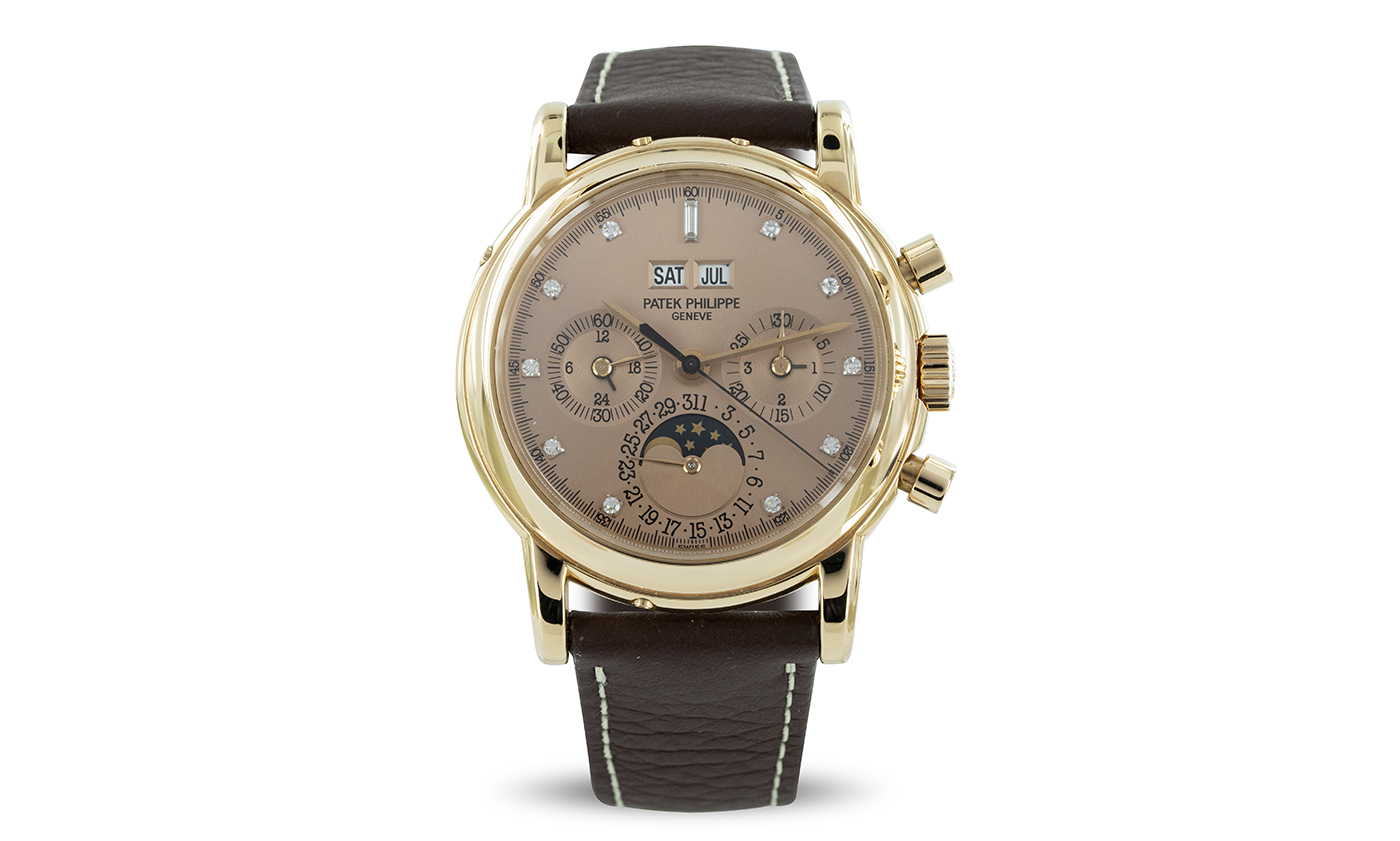
Patek Philippe 3970R, a special order made in 1993 in pink gold with diamond indexes.
Patek Philippe Chronographs
The OAK Collection exhibition includes 29 Patek Philippe chronographs, all but six of which are rarest-of-the-rare vintage pieces. Among them are two Ref. 1579 chronographs with the model’s distinctive spider lugs. One is in steel, made circa 1950, with a silvered dial. It is one of only six made. The other is platinum and is one of only three ever made. Both are exhibited on gorgeous light blue straps. Also notable is a 1956 Reference 530R pink gold chronograph double-signed with the name of its original retailer, Gobbi Milano.

Patek Philippe Ref. 1579 A chronograph, made around 1950, in stainless steel chronograph, silvered dial with applied indexes, tachometer scale, case with spider lugs. One of only six made.



Patek Philippe Ref. 530R, retailed by Gobbi Milano.
Patek World Times
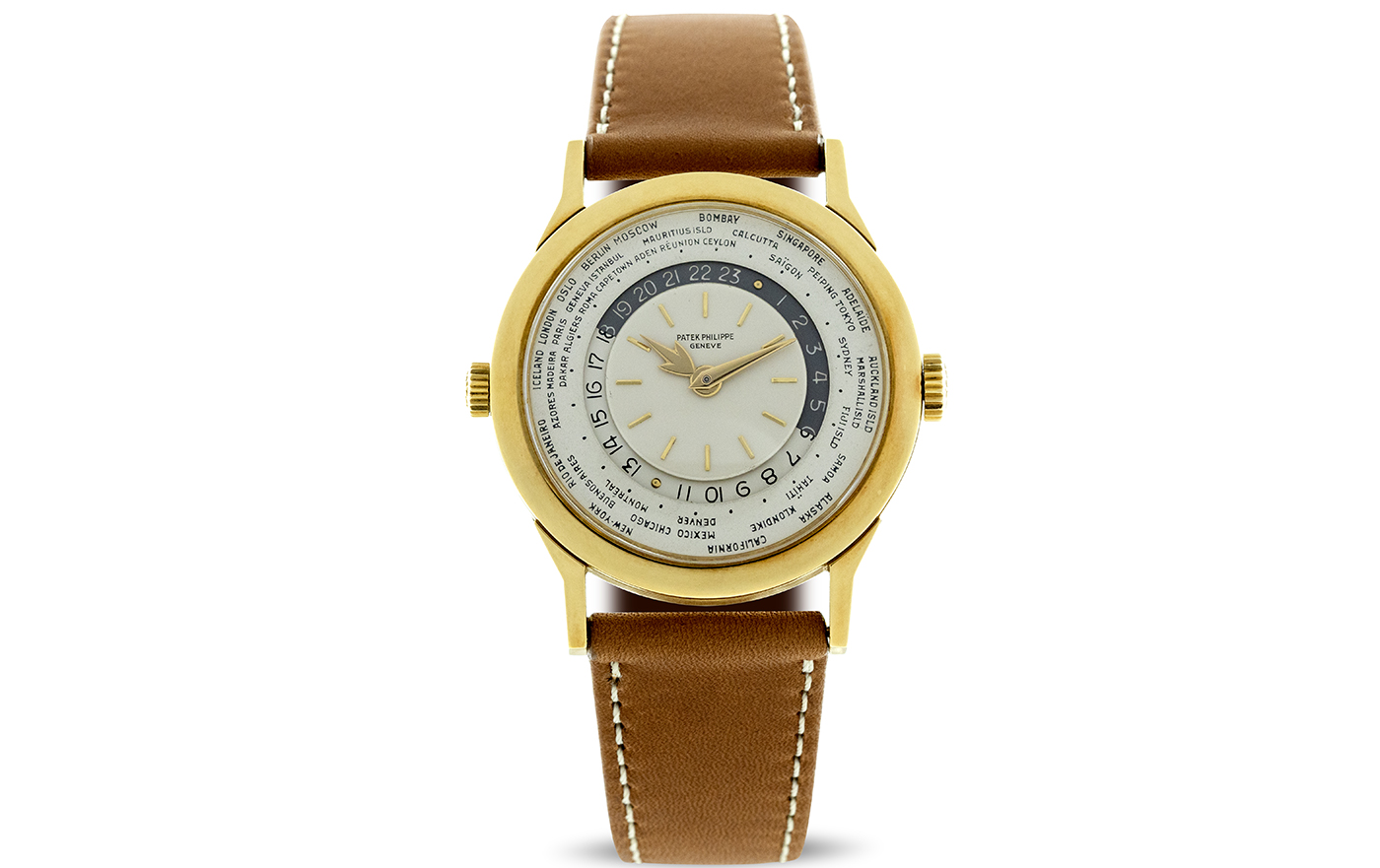
Patek Philippe Ref.25231J, a very rare second-generation piece in yellow gold.
Patek Phillippe World Time watches, first developed in collaboration with watchmaker Louis Cottier in the 1930s, are highly covetable for their rare dial variants. The highlight of this section is the Ref. 51311P (below) in yellow gold with two crowns and an intense blue enamel center. It is one of only three pieces made of the reference. Another highlight is the Ref. 2523J (above), a rare second generation in yellow gold, also with a double crown. There are several in the collection with cloisonné enamel centers, including the Ref. 605 HU, depicting a map of North America, one of only six known such references in pink gold.
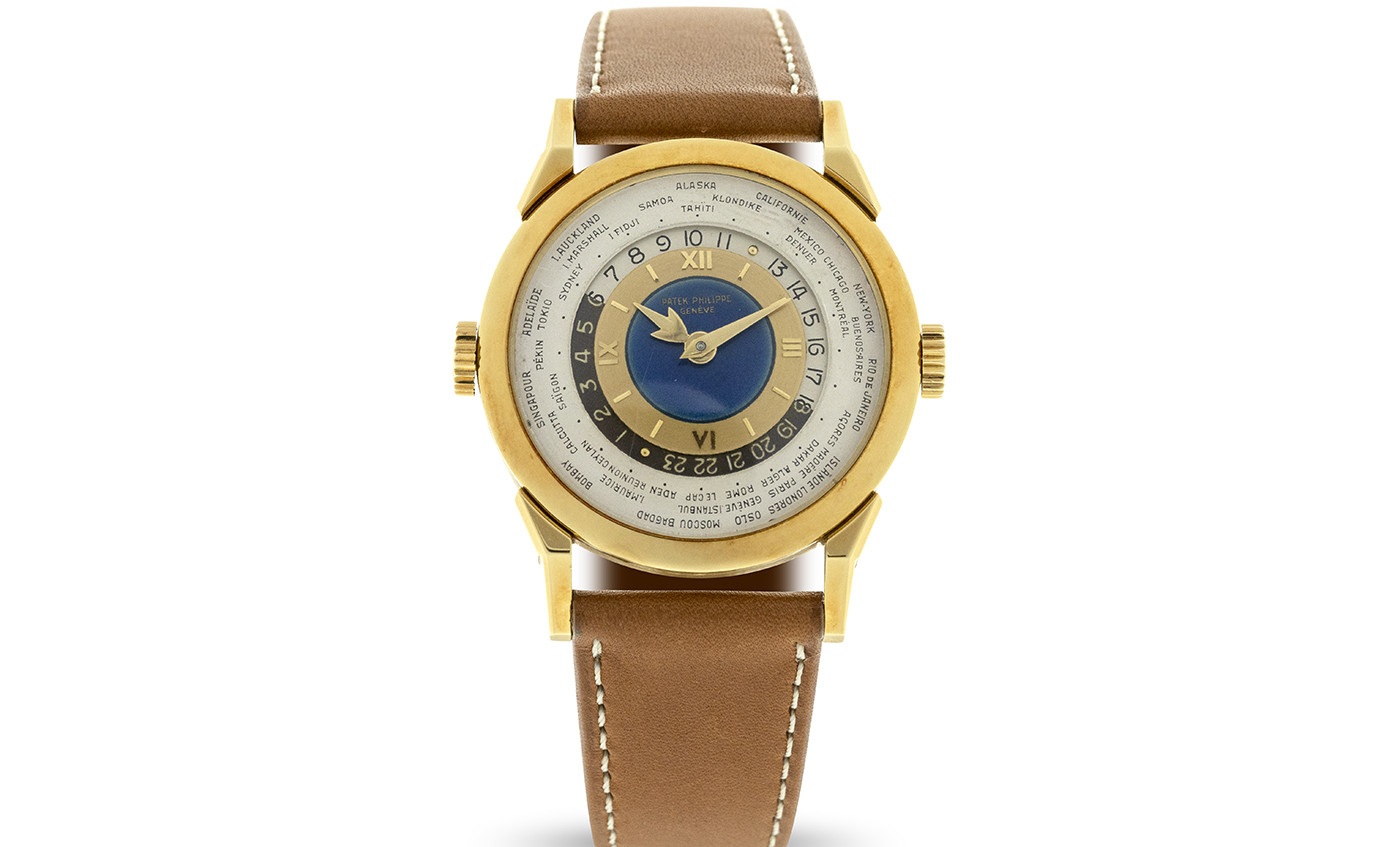
Patek Philippe Ref. 51311P in yellow gold with two crowns and an intense blue enamel center. It is one of only three pieces.
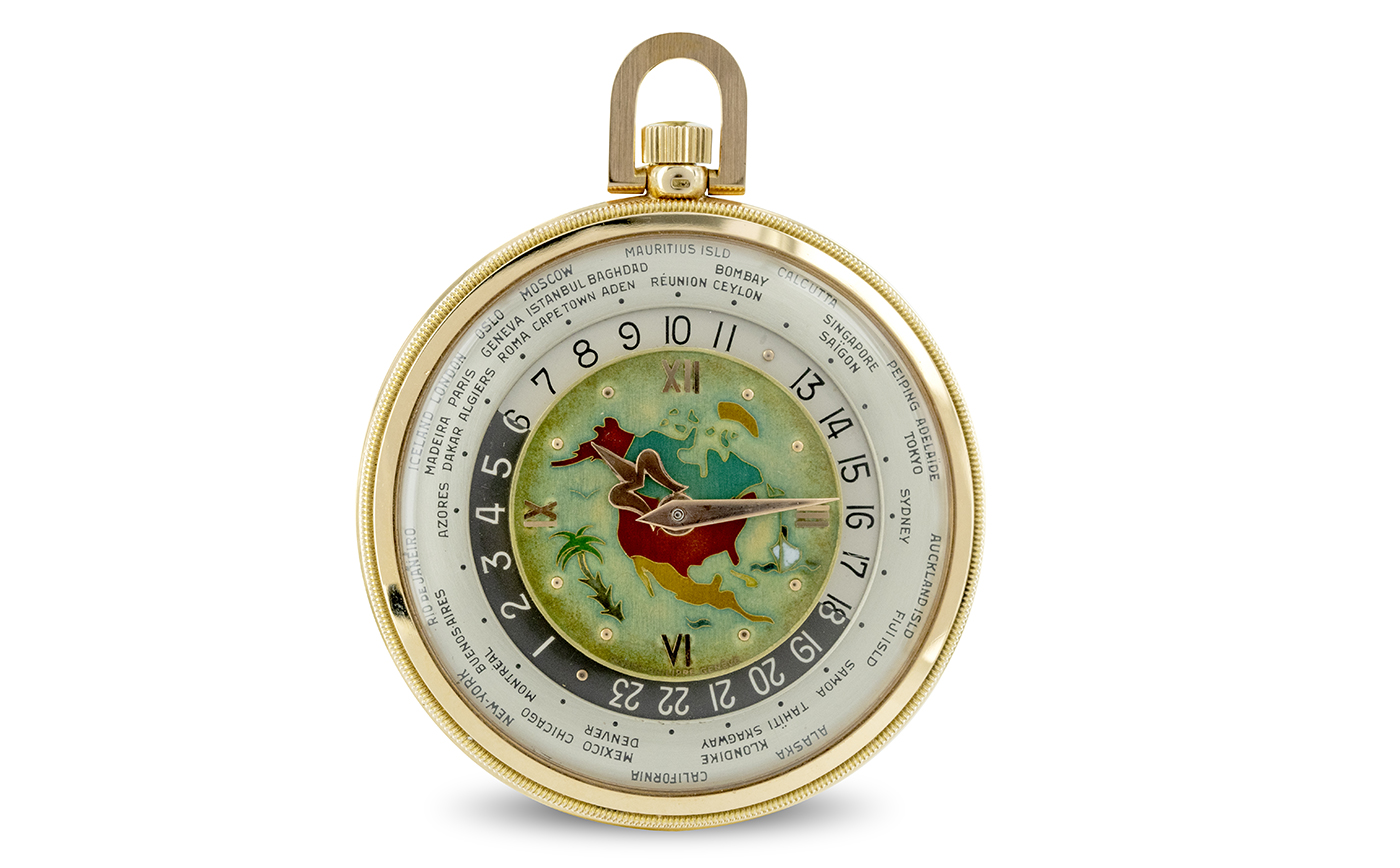
Patek Philippe Ref. 605 HU, depicting a map of North America in the center, one of only six known such references in pink gold.
Nautilus

Patek Philippe Ref. 37001 in steel, a first-series “Jumbo” Nautilus made circa 1979.
In a more contemporary vein, there are several outstanding Nautilus models, including a yellow gold version retailed by Gobbi, a notable dealer in Milan, in yellow gold with a discreet row of diamonds around the outside of the very wide bezel (below). The diamonds make it a unique piece. Also notable is the Ref. 37001 in steel (above), a first-series “Jumbo” Nautilus made circa 1979, with a date window, on a bracelet and with an automatic movement.
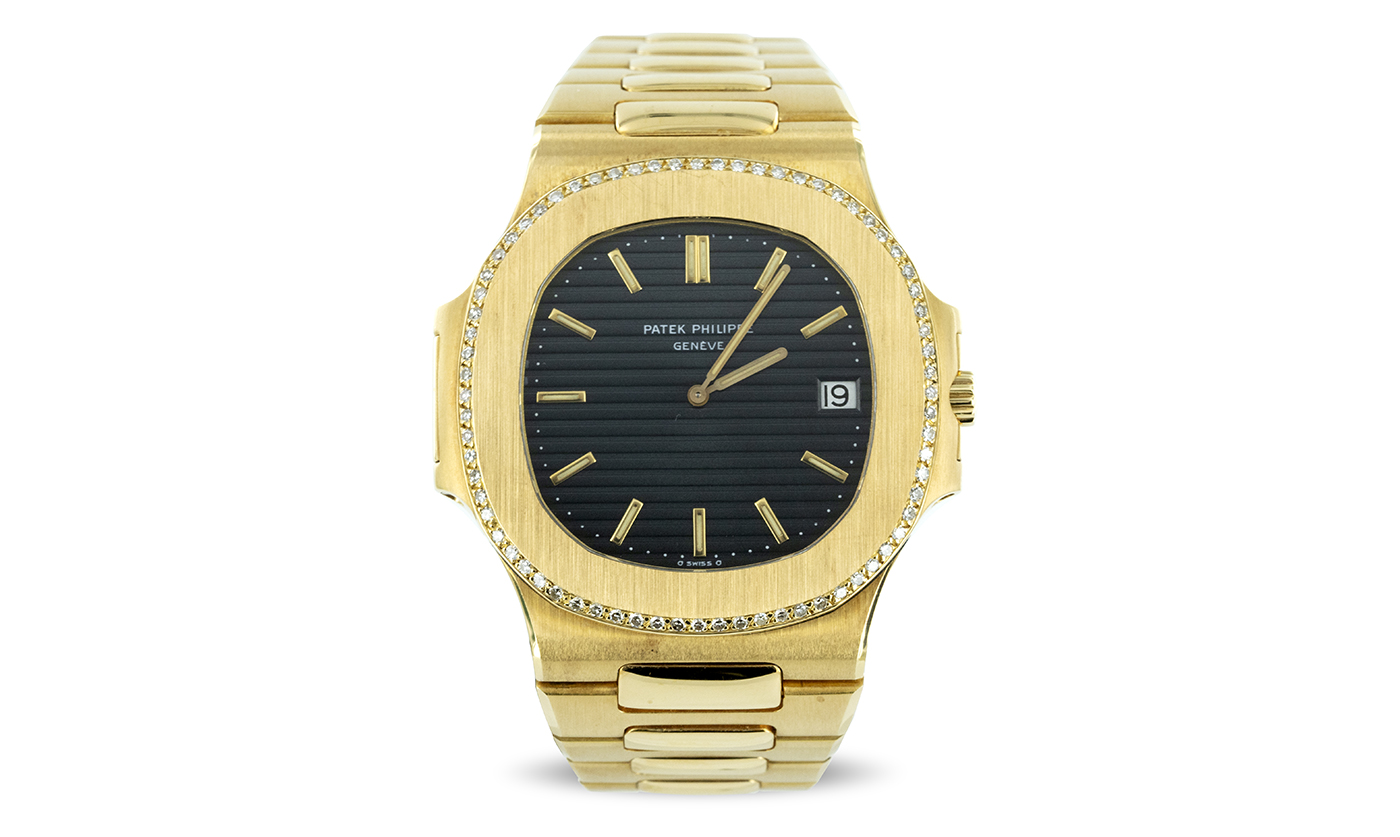
One-of-a-kind Nautilus retailed by Gobbi Milano, in yellow gold with a discreet row of diamonds on the bezel.
The Nautilus section also includes the one-of-a-kind Ref. 5726/1A (below), made for Getreide in 2016. It’s a steel automatic annual calendar with moon phases, 24-hour indication, and sweep center seconds, stamped with the Patek Philippe Seal. The Ref. 5726 was launched in 2010 in stainless steel only with a leather strap. In 2012 Patek began production of the reference 5726/1A, which came with a stainless steel bracelet. Ref. 5726/1A-001 is available with black dial or silvery white dial (ref. 5726/1A-010). The Ref. 5726/1A-012 (above), is fitted with a never before seen blue-black dial.

One-of-a-kind Patek Philippe Nautilus Ref. 5726/1A, made for Getreide in 2016 with a special blue/black dial.
Graves
Patek Philippe’s most legendary patron was Henry Graves Jr, a banker and railroad tycoon who, between 1922 and 1951, commissioned 39 watches from the revered maker. Of those, only around 30 are believed to have survived, five of which are in the OAK Collection. The only larger selection of Graves watches belonging to a single entity is that on display at the Patek Philippe Museum, which holds 13.
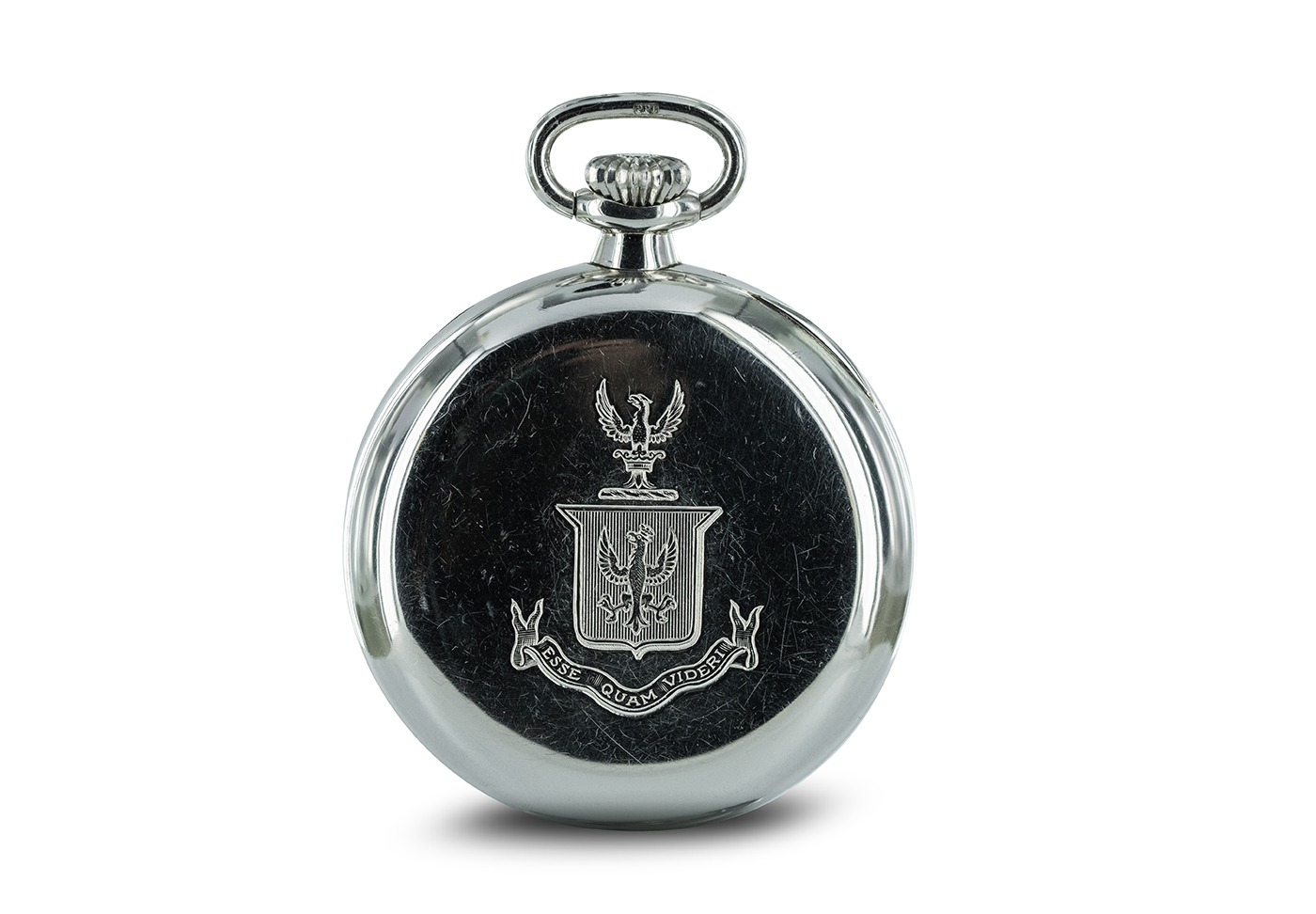
The Graves Patek Philippe Tourbillon Observatory Quality in platinum, made circa 1932.
The highlight is an Observatory quality platinum-cased tourbillon pocket watch (above) created by Patek Philippe to be entered in the Geneva Astronomical Observatory Timing Contest of 1933 — which it won, making it one of the world’s most accurate mechanical watches. Another impressive Graves piece is a yellow gold pocket watch “two-train minute repeater” — one gear train for the time and one for the repeater. Probably fewer than 100 of these types of movements were ever made.
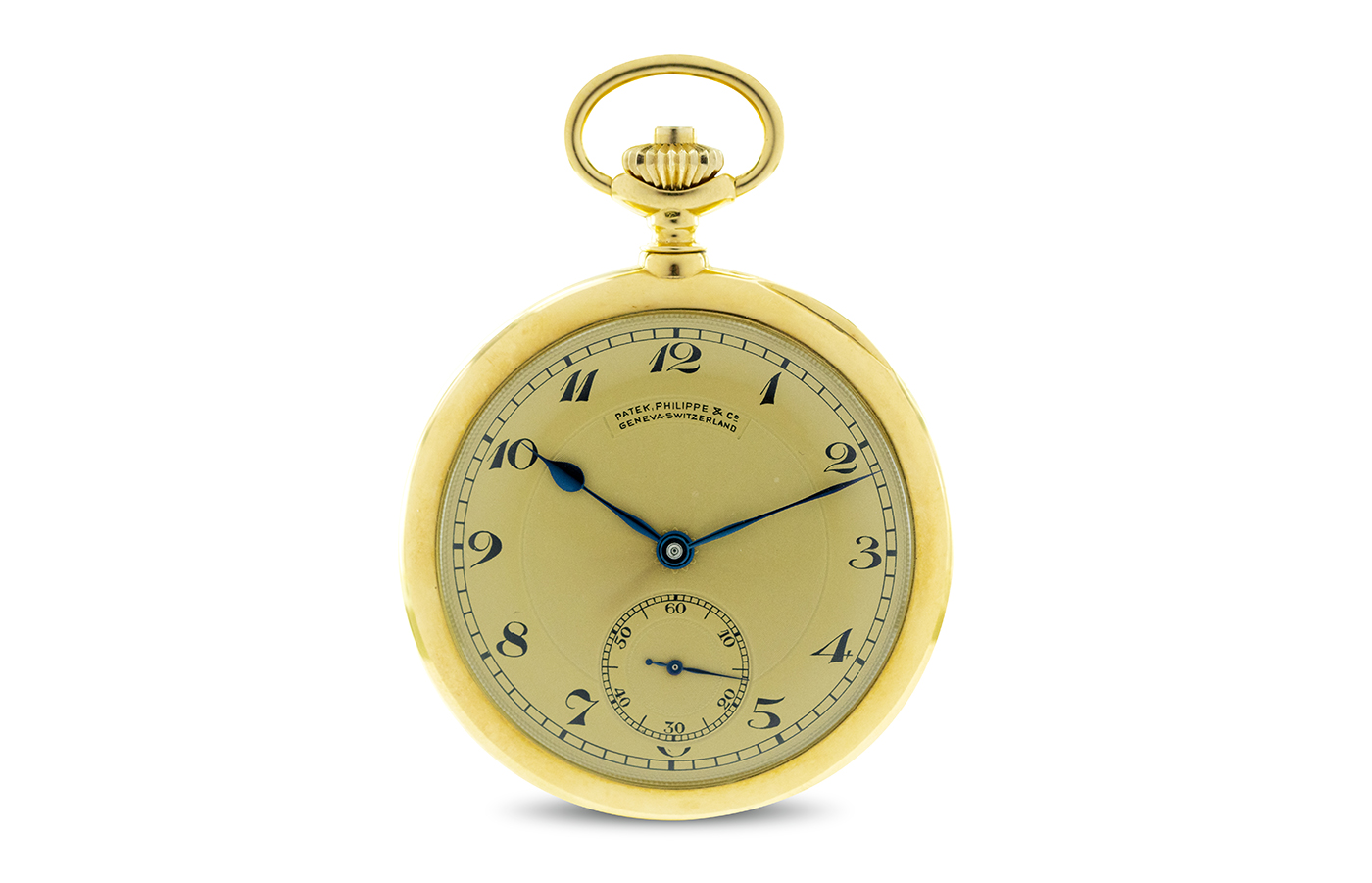
The Graves Patek Philippe two-train minute repeater pocket watch in yellow gold.
Patek Philippe Calatravas
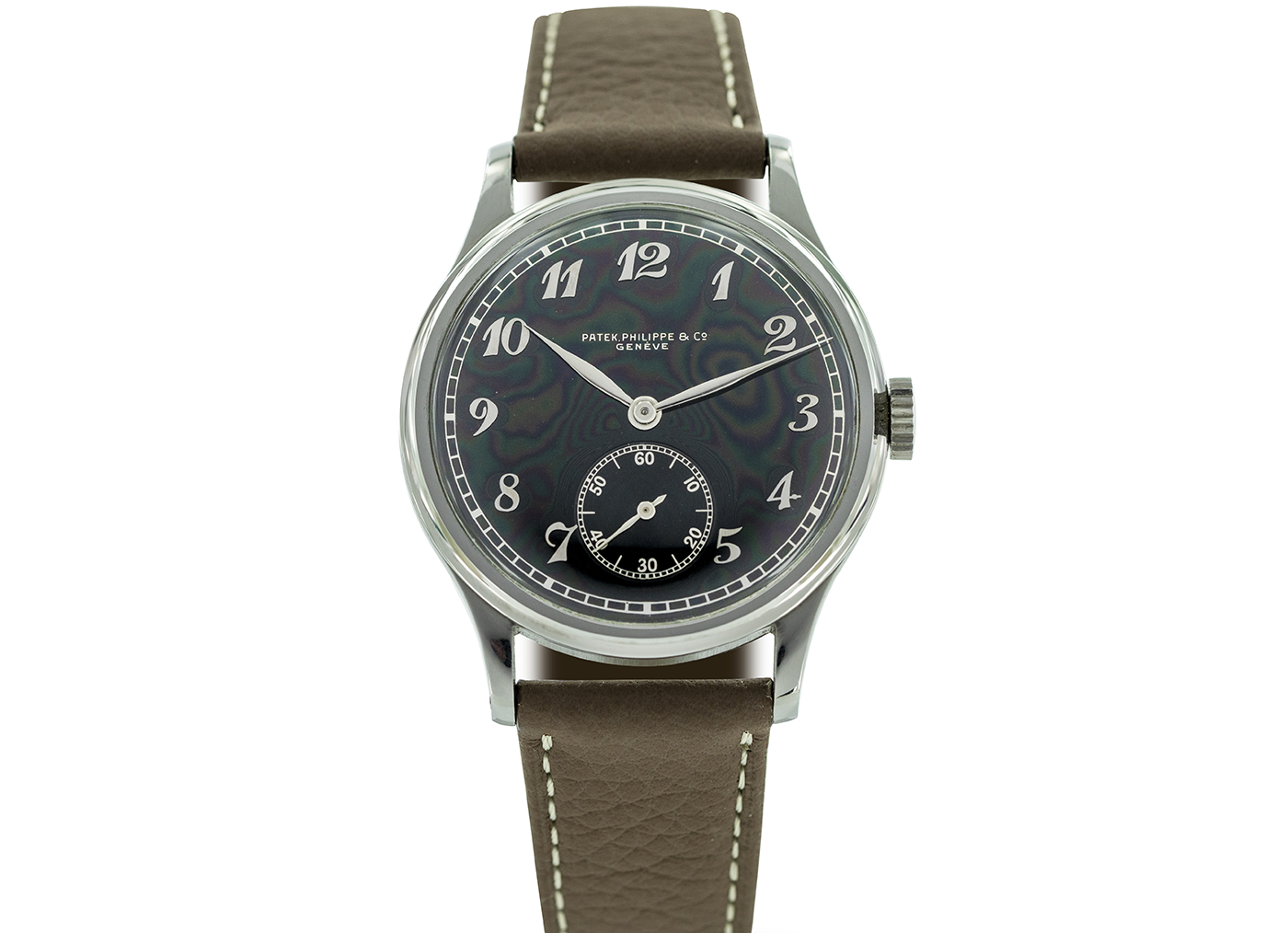
Patek Philippe- Calatrava Ref.530A, a one-of-a-kind.
Patrick Getreide has accumulated the largest number of Calatrava models in any private collection, several of which are unique vintage models or modern pieces made specifically for him. Among the 20 Calatravas on display at the British Design Museum, there are 12 vintage pieces, four modern ones, and three that are one-of-a-kinds. Particular stars include the unique Reference 530A (above) in steel with a black dial.

Calatrava section: Patek Philippe Ref. 570R Calatrava one-of-a-kind, made in 1943, known as a “Heures Penchées Breguet”, referring to its slanted numerals.
There is also a Ref. 570R in pink gold with matching two-tone rose dial. The Ref 570 is another outstanding piece. It was in production from the late 1930s until the early 1970s, and the Oak collection has examples from all important periods, including a Ref 570J owned by Andy Warhol that is double-signed by the Roman retailer Hausmann and Co, one of the world’s most historically important retailers.

Patek Philippe Ref. 570J Calatrava with a black dial, signed by Gübelin.
Patek Philippe Rare Handcrafts
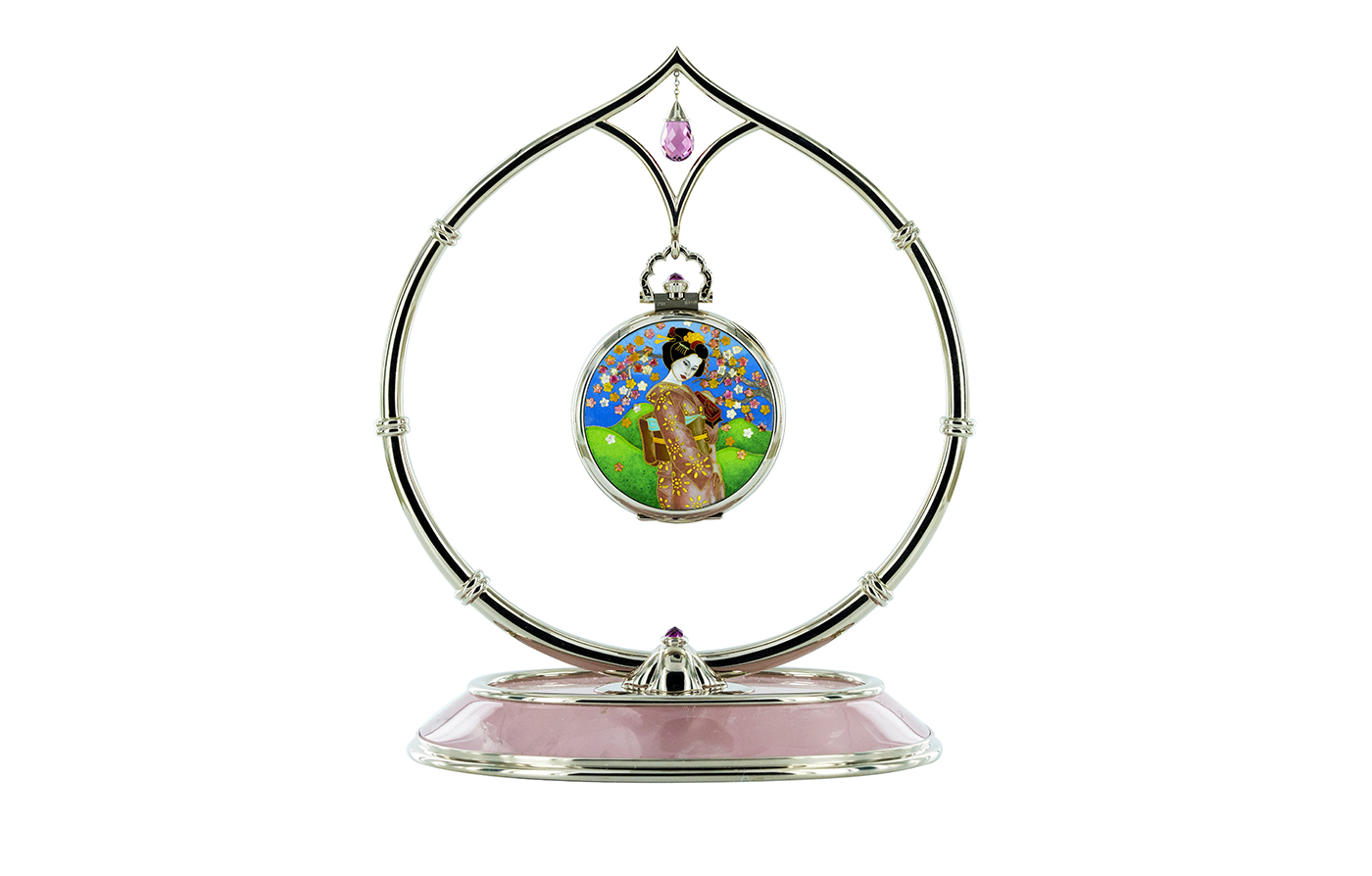
Patek Philippe Ref. 98214OG, a one-of-a-kind piece, with enamel depiction of a Japanese Geisha.
Patek Philippe has always been one of the most important masters of the so-called “Geneva style,” a level of artisanship that is unlike anywhere else in Switzerland. Since the 1600s, Geneva watches were recognized as high-quality products, reputed for their fine workmanship and metiers execution, including engraving and enamel decoration. They were considered Switzerland’s most beautiful and aesthetically sophisticated creations, whereas other regions were more intent on producing in large quantities. Ever since Patek Philippe was founded in 1839, it has been working with gifted artisans to decorate its watches. The OAK collection exhibit includes 12 Patek Philippe watches and clocks from its Rare Handcrafts collections, all extremely rare or one-of-a-kind.
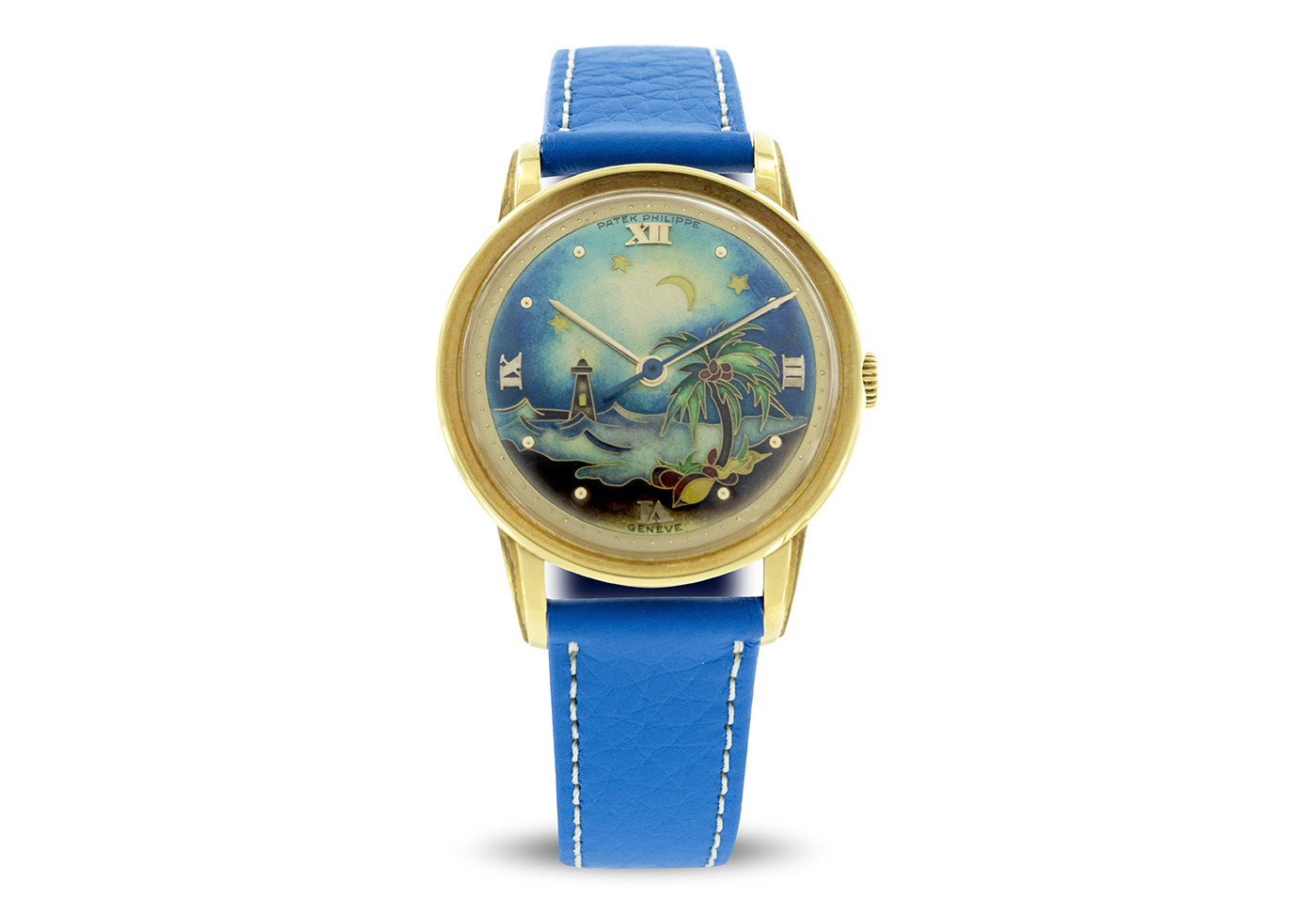
Patek Philippe Ref. 2481 depicts a lighthouse scene.
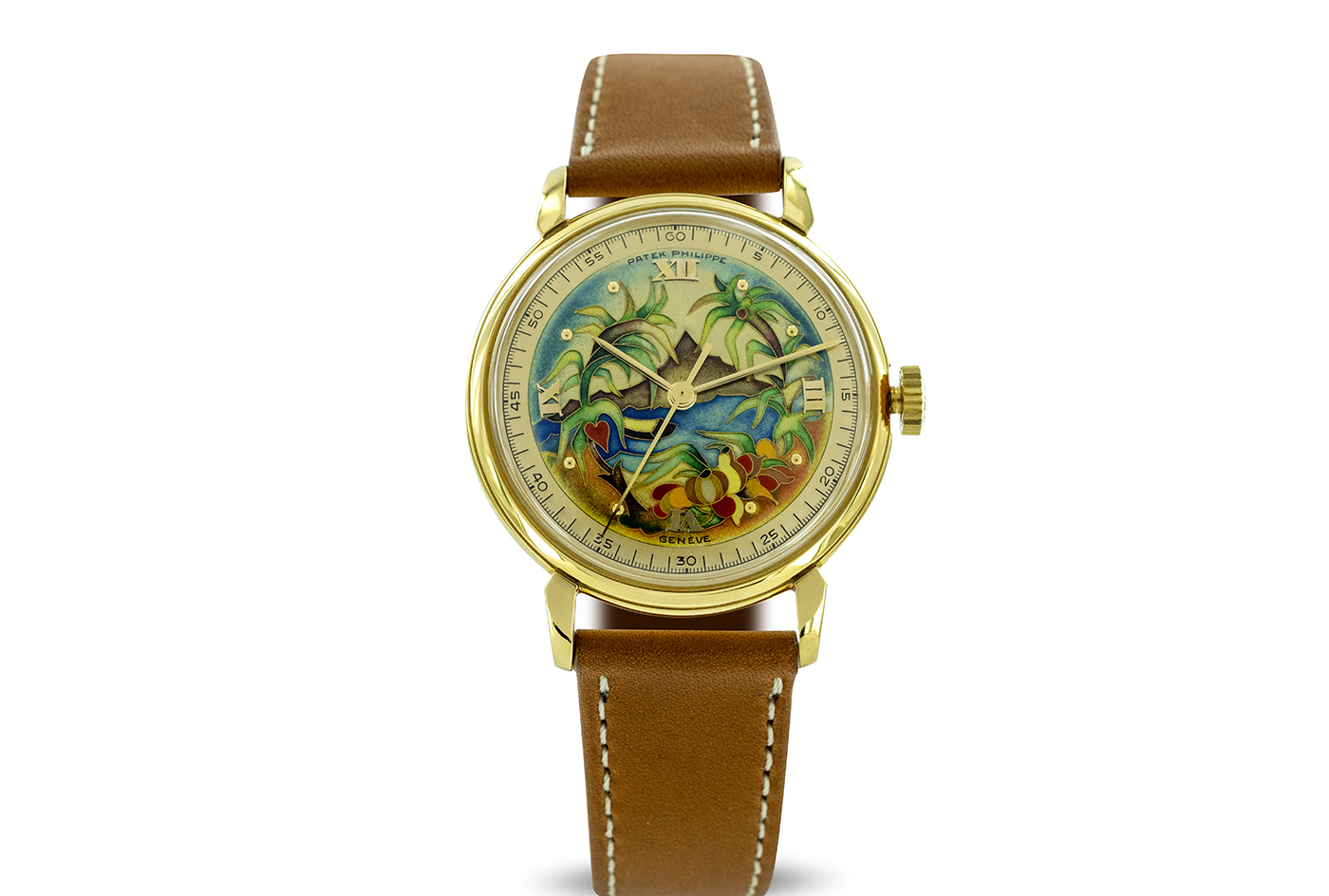
Patek Philippe Ref. 2482, with enamel cloisonné, entitled “The Island.”
Rolex Chronographs
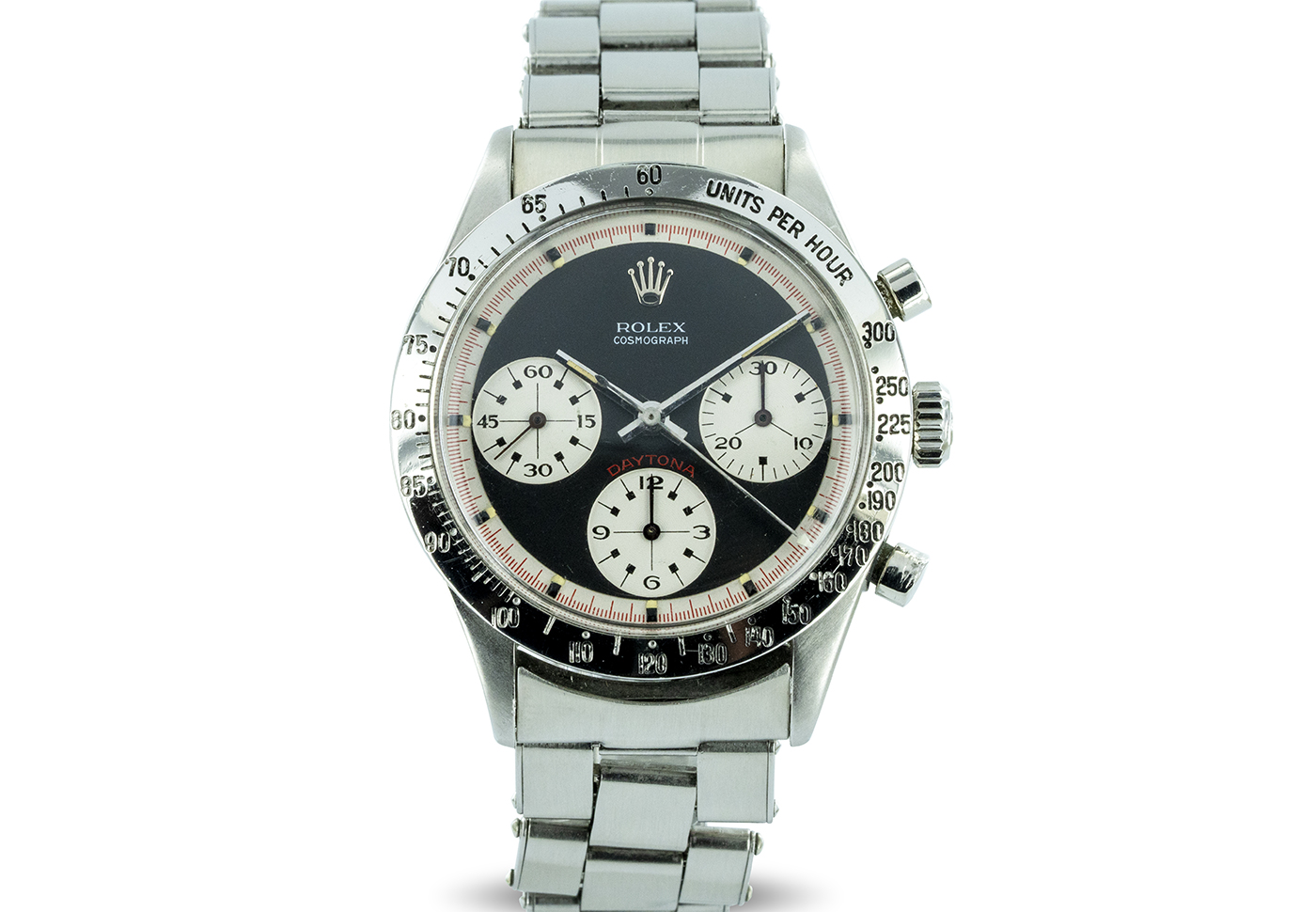
Rolex Daytona Ref. 6239 “NASA.”
The OAK collection exhibition traces the evolution of the Rolex Oyster chronograph from its early days, starting with a Ref. 4500, a two-subdial model from the 1940s, and progressing to the three-subdial Ref. 6034 and Reference 6036 triple-calendar models of the following decades. It includes many examples of the now-legendary (and almost impossible to get) Cosmograph Daytona, first seen in 1963. Examples include several with Paul Newman dials, one of which was originally owned by NASA astronaut Walter Cunningham (above) and one of the rarest of all, a special model made for the Fuerza Aerea del Peru (FAP), a Peruvian military force created by the merger of the Peruvian army and navy.
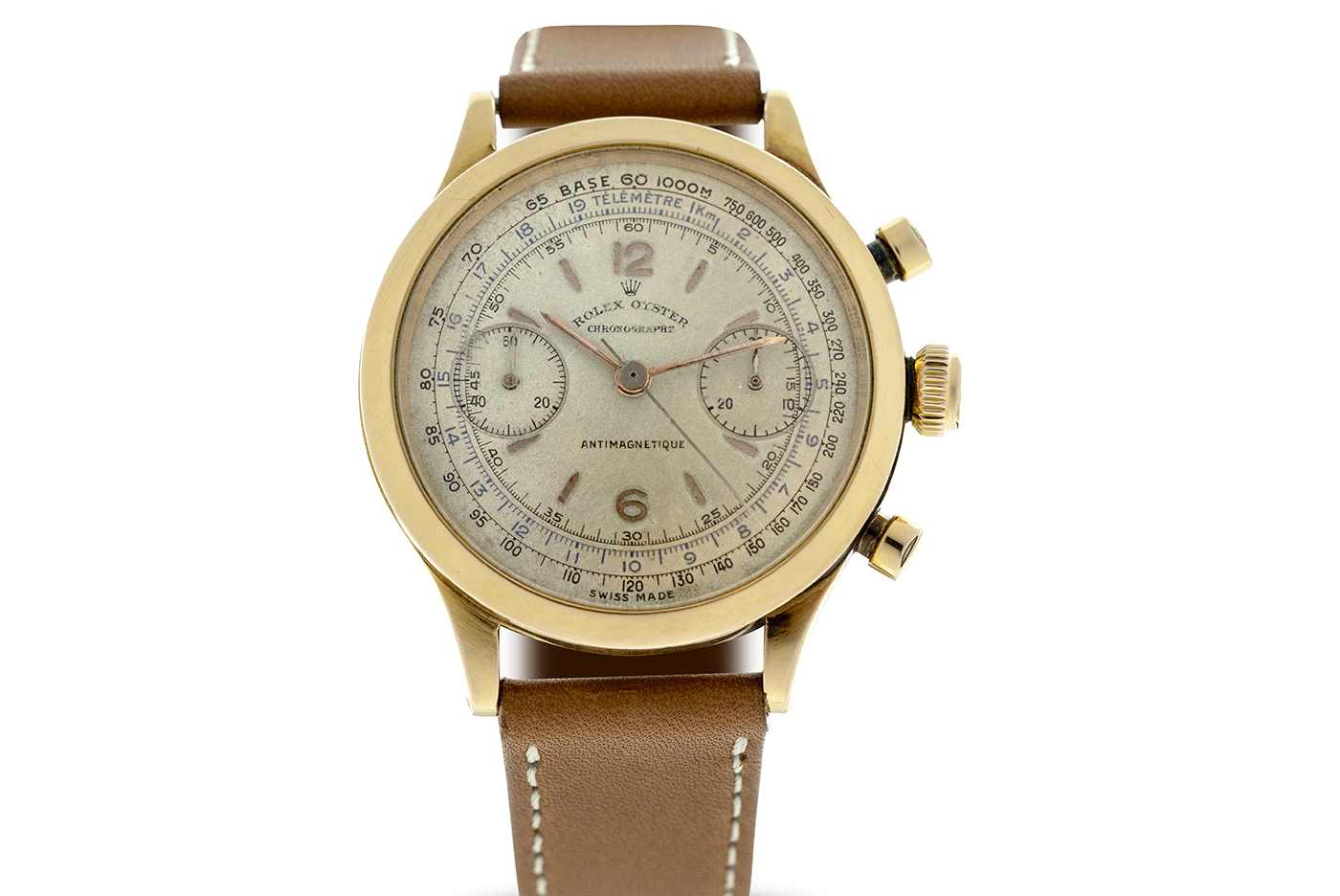
Rolex Ref. 3525 “Monoblocco Togliatti” given to the doctor of the Secretary General of the left-wing Italian PCI party from 1927 to 1964, and one of the founding fathers of post-fascist Italy.
There is also the Rolex Ref. 3525 “Monoblocco Togliatti” (above) given to the doctor who saved the life of Palmiro Togliatti, the Secretary General of the left-wing Italian PCI party from 1927 to 1964 and one of the founding fathers of post-fascist Italy. The engraving on the caseback bears this commemorative inscription: Palmiro Togliatti, al Dott. P. Biocca, riconoscente, 14- 7-1948 (Palmiro Togliatti to Dr. P. Biocca with gratitude). It is one of a kind.
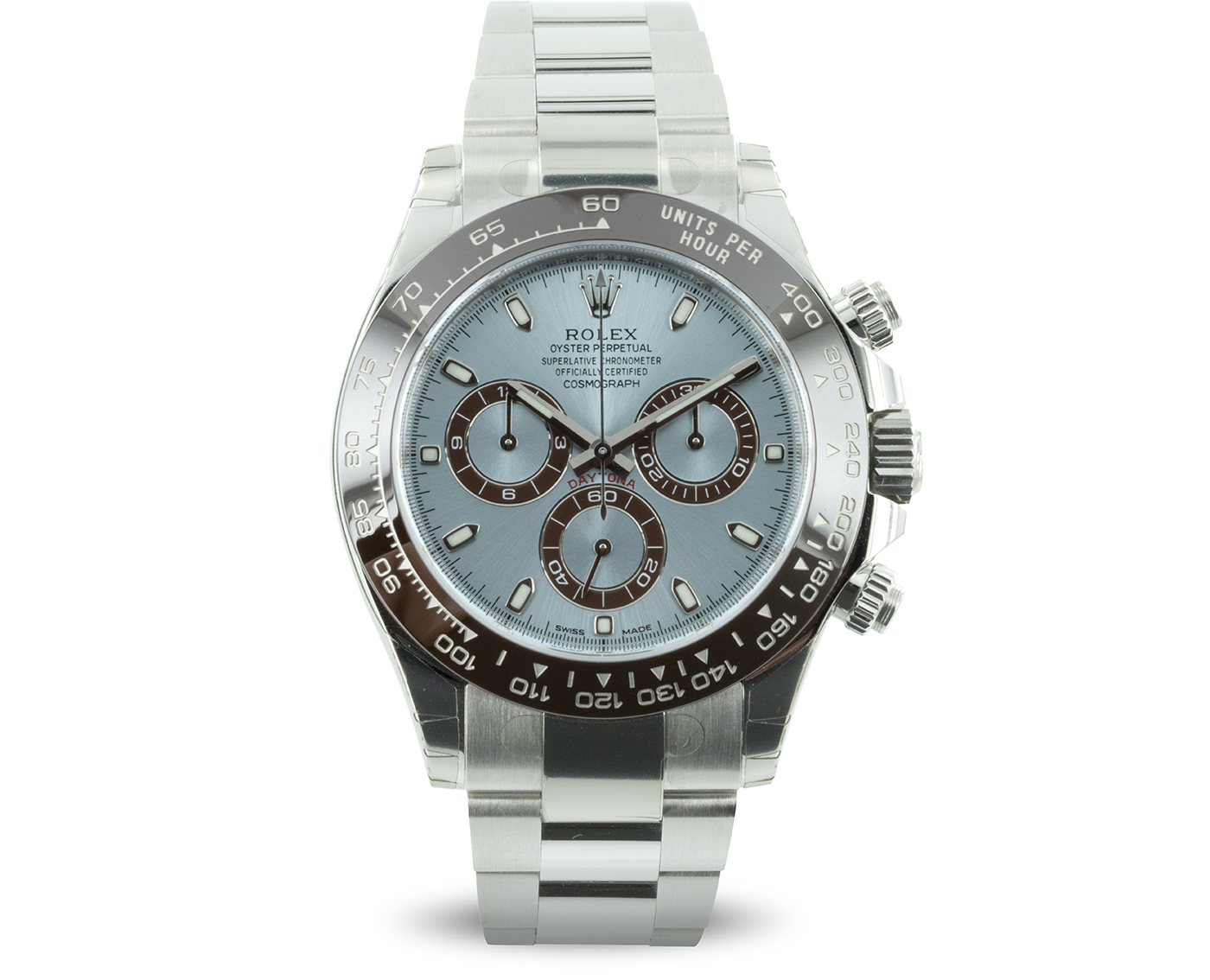
The first platinum Daytona Ref. 116506, introduced in 2013.
The collection also includes the very first example sold of the platinum-cased Daytona with ice-blue dial, launched in 2013. It was acquired by Getreide from a charity auction and remains in pristine, unworn condition.
Rolex Sports Watches
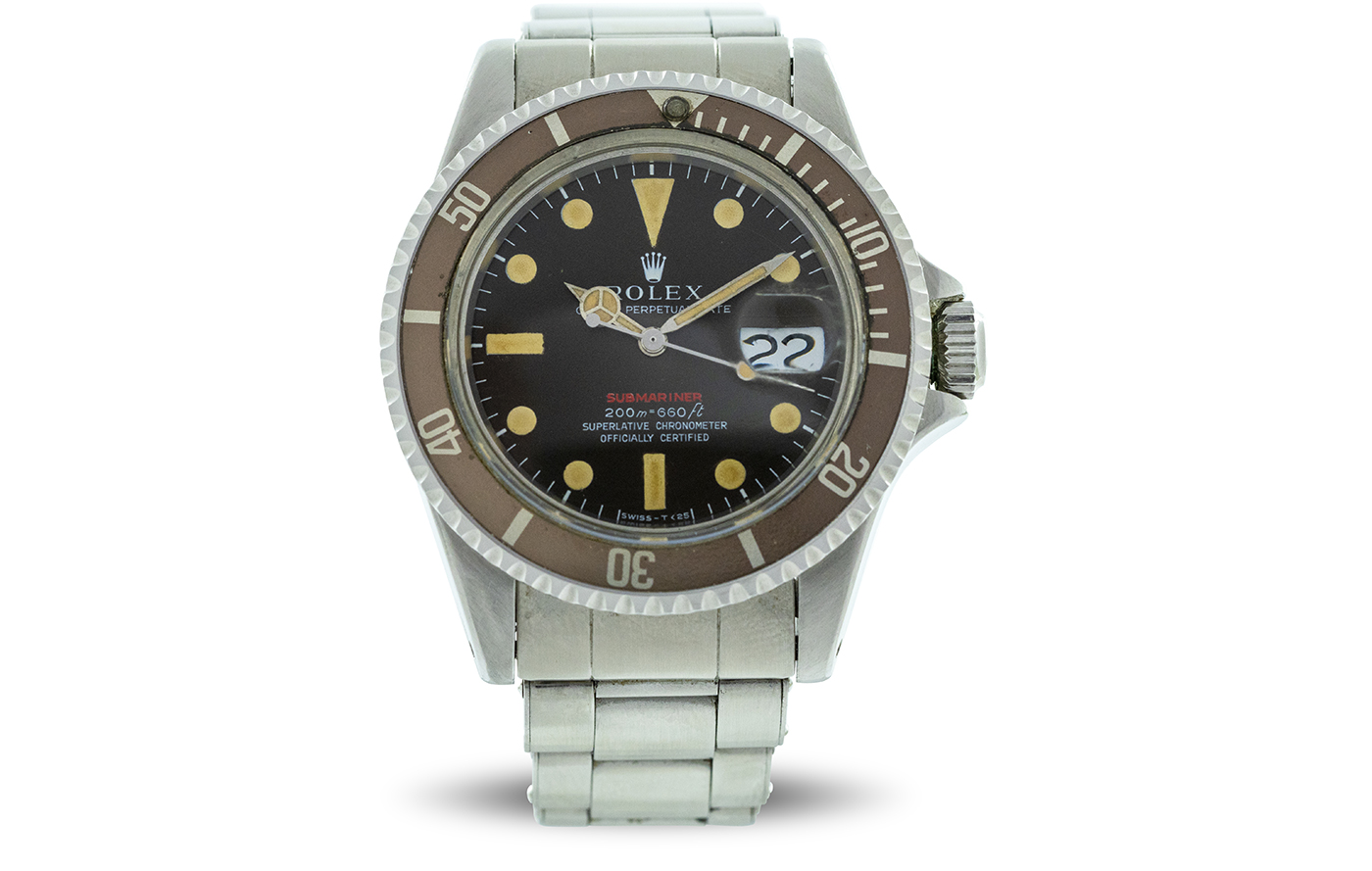
Rolex Ref. 1680 Submariner Red, the first with a cyclops date window.
Rolex has always been at the forefront of sports watches, and it remains at the core of the brand’s production. The brand is unmatched for robustness, which explains why so many vintage models are so highly collectible — they age well and work through anything. Oyster Perpetual, meaning “waterproof,” with an automatic winding system — defines most series in the brand’s production in both the modern and historic sense. The OAK collection includes a representative historic sample that traces the development of the Rolex sports watch, including a 1973 Submariner Ref. 1680 Submariner Red, a steel diver’s watch with a Mark II dial (meters first, followed by chronometer rating). The 1680 is a “transitional” reference, in that was the first Submariner to feature a date complication magnified by the famous cyclops lens.
Rolex GMT-Masters
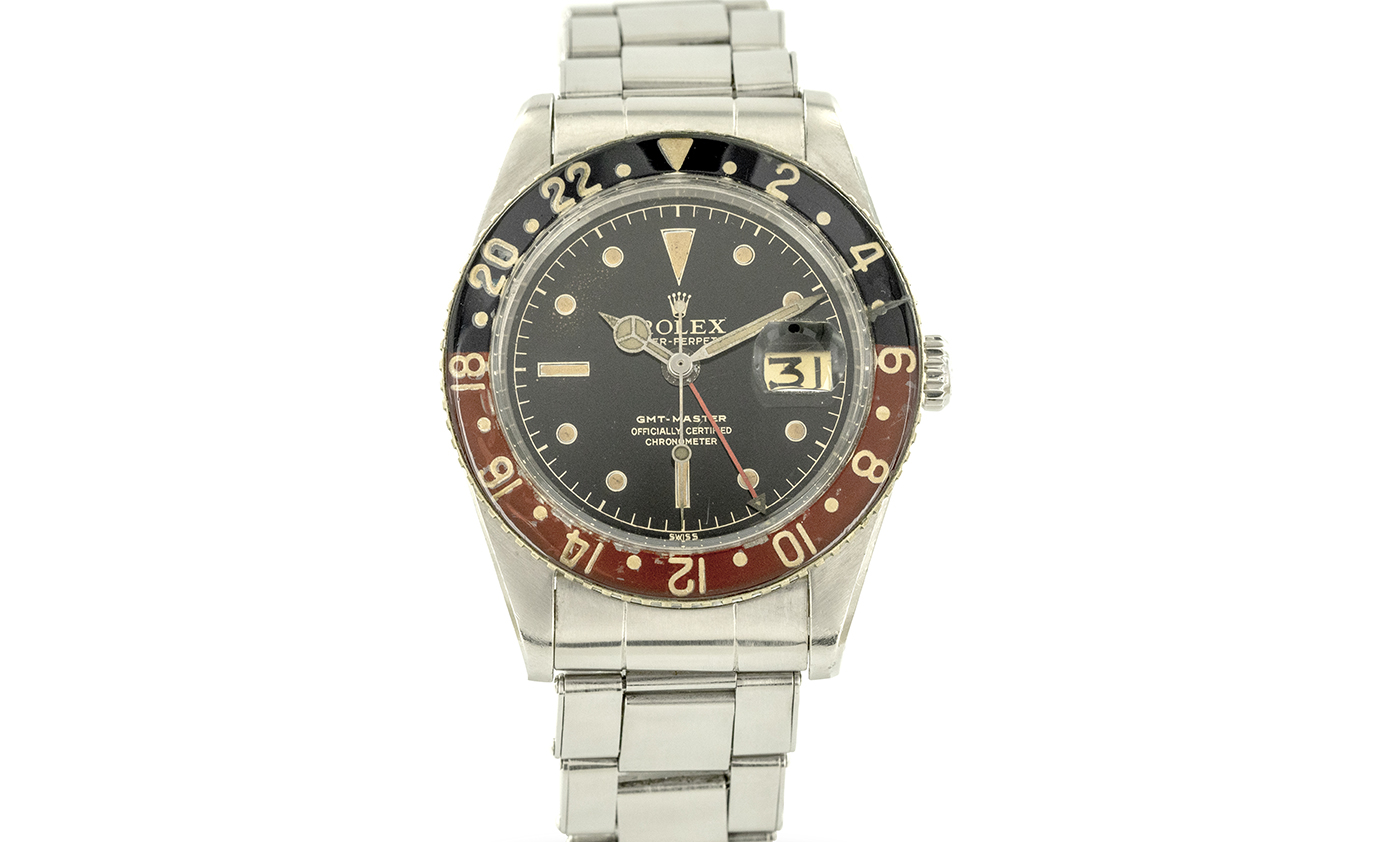
Rolex GMT-Master Ref. 6542 “Pussy Galore.”
The GMT-Master’s history began with Pan Am commissioning Rolex to develop a watch for its pilots in the 1940s and 1950s, to help them keep time in multiple zones. The GMT-Master back then was notable for its Bakelite bezel and fourth hand to calculate a second time-zone. The collection includes such GMT-Master notables as the “Pussy Galore” worn by the villain of that name in the 1964 James Bond film “Goldfinger” and a Ref. 17600 Pepsi bezel model worn by astronaut Chuck Yaeger.
Independents
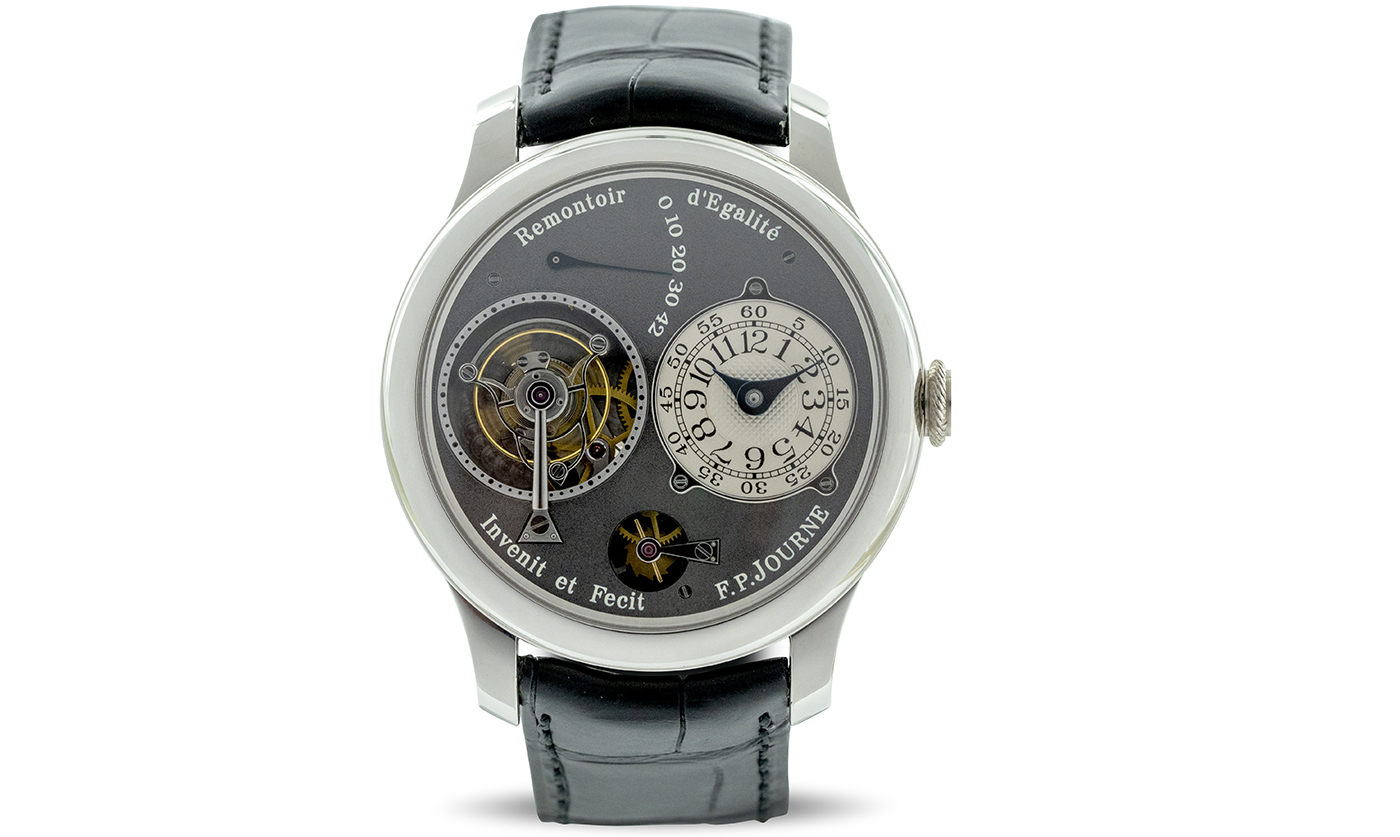
F.P. Journe Tourbillon Souverain.
The Independents section of the exhibit is dedicated, in particular, to two masters of the category: F.P. Journe and Kari Voutilainen. Voutilainen is known for his beautiful flinqué enamel dials, with translucent enamel over engraved gold backgrounds. Francois-Paul Journe, who restored some of the world’s most important historical timepieces, designed and built unique pocket watches to order, some for other brands, before starting his own label. In 1999, he launched his own brand under the label “F.P. Journe Invenit et Fecit.”
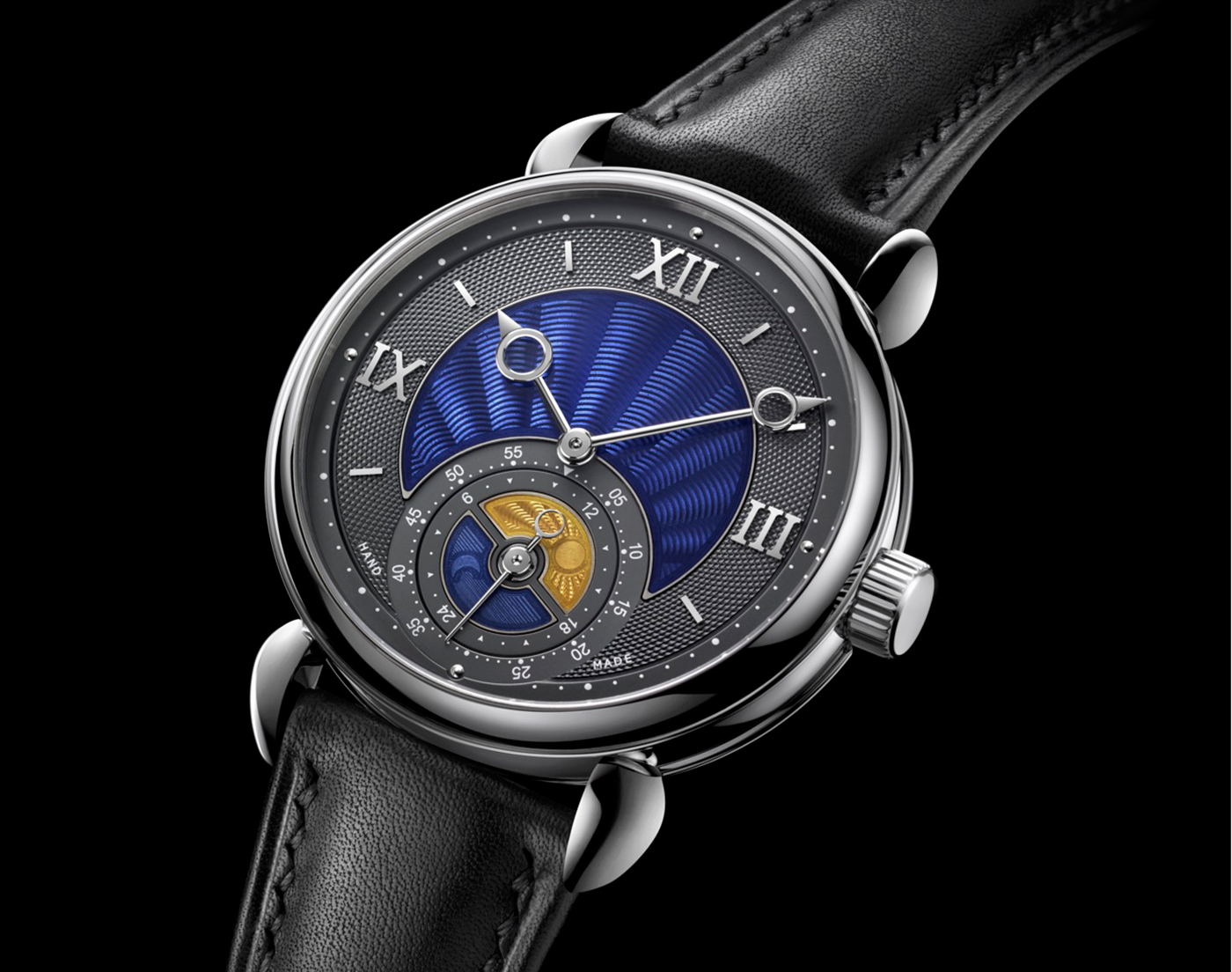
Flinque enameled watch by Kari Voutilainen, a one-of-a-kind piece bought at the ONLY watch auction for charity.
Let’s hope that the precedent the OAK Collection is setting as the first private collection to be featured in a museum or a gallery catches on.

